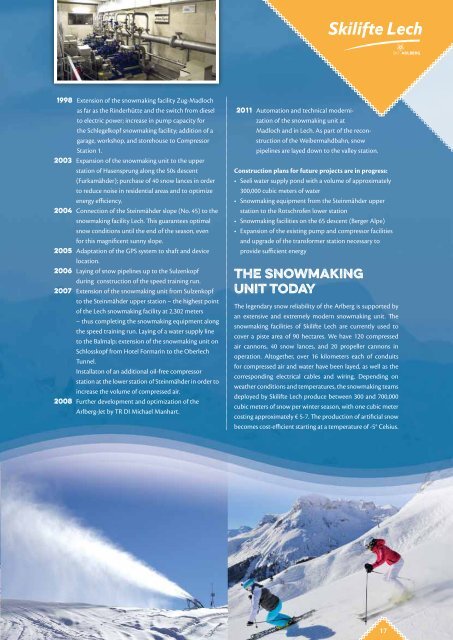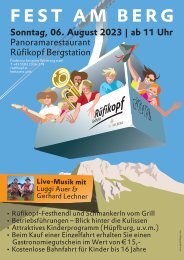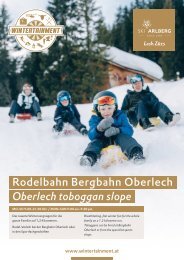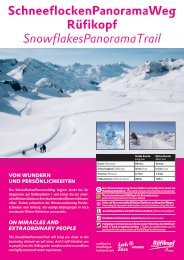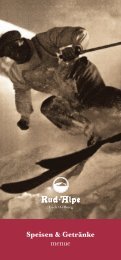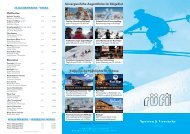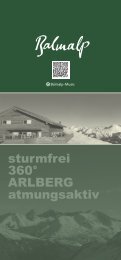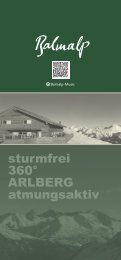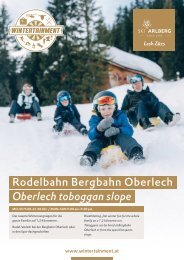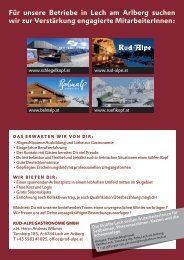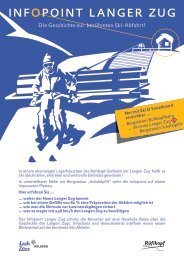Magazin_Skilifte Lech_E
Create successful ePaper yourself
Turn your PDF publications into a flip-book with our unique Google optimized e-Paper software.
1998 Extension of the snowmaking facility Zug-Madloch<br />
as far as the Rinderhütte and the switch from diesel<br />
to electric power; increase in pump capacity for<br />
the Schlegelkopf snowmaking facility; addition of a<br />
garage, workshop, and storehouse to Compressor<br />
Station 1.<br />
2003 Expansion of the snowmaking unit to the upper<br />
station of Hasensprung along the 50s descent<br />
(Furkamähder); purchase of 40 snow lances in order<br />
to reduce noise in residential areas and to optimize<br />
energy efficiency.<br />
2004 Connection of the Steinmähder slope (No. 45) to the<br />
snowmaking facility <strong>Lech</strong>. This guarantees optimal<br />
snow conditions until the end of the season, even<br />
for this magnificent sunny slope.<br />
2005 Adaptation of the GPS system to shaft and device<br />
location.<br />
2006 Laying of snow pipelines up to the Sulzenkopf<br />
during construction of the speed training run.<br />
2007 Extension of the snowmaking unit from Sulzenkopf<br />
to the Steinmähder upper station – the highest point<br />
of the <strong>Lech</strong> snowmaking facility at 2,302 meters<br />
– thus completing the snowmaking equipment along<br />
the speed training run. Laying of a water supply line<br />
to the Balmalp; extension of the snowmaking unit on<br />
Schlosskopf from Hotel Formarin to the Oberlech<br />
Tunnel.<br />
Installaton of an additional oil-free compressor<br />
station at the lower station of Steinmähder in order to<br />
increase the volume of compressed air.<br />
2008 Further development and optimization of the<br />
Arlberg-Jet by TR DI Michael Manhart.<br />
2011 Automation and technical modernization<br />
of the snowmaking unit at<br />
Madloch and in <strong>Lech</strong>. As part of the reconstruction<br />
of the Weibermahdbahn, snow<br />
pipelines are layed down to the valley station.<br />
Construction plans for future projects are in progress:<br />
• Seeli water supply pond with a volume of approximately<br />
300,000 cubic meters of water<br />
• Snowmaking equipment from the Steinmähder upper<br />
station to the Rotschrofen lower station<br />
• Snowmaking facilities on the 65 descent (Berger Alpe)<br />
• Expansion of the existing pump and compressor facilities<br />
and upgrade of the transformer station necessary to<br />
provide sufficient energy<br />
The Snowmaking<br />
Unit Today<br />
The legendary snow reliability of the Arlberg is supported by<br />
an extensive and extremely modern snowmaking unit. The<br />
snowmaking facilities of <strong>Skilifte</strong> <strong>Lech</strong> are currently used to<br />
cover a piste area of 90 hectares. We have 120 compressed<br />
air cannons, 40 snow lances, and 20 propeller cannons in<br />
operation. Altogether, over 16 kilometers each of conduits<br />
for compressed air and water have been layed, as well as the<br />
corresponding electrical cables and wiring. Depending on<br />
weather conditions and temperatures, the snowmaking teams<br />
deployed by <strong>Skilifte</strong> <strong>Lech</strong> produce between 300 and 700,000<br />
cubic meters of snow per winter season, with one cubic meter<br />
costing approximately € 5-7. The production of artificial snow<br />
becomes cost-efficient starting at a temperature of -5° Celsius.<br />
17


